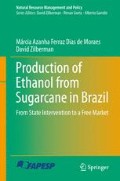Abstract
The change in the institutional environment, initiated by Directive no. 94 and later supplemented by Directive no. 294, also caused considerable concern not only among the owners of sugar mills and ethanol plants but also among the sugarcane suppliers, who had until then traded sugarcane on the basis of the official prices dictated by the government (through the Executive Office for Regional Development). The lifting of price controls on anhydrous ethanol, hydrous ethanol, and sugarcane (scheduled for May of 1998) called for a new form of remuneration for sugarcane to take the place of the previous system of prices tabulated by the government. The new system would have to meet the needs of sugarcane suppliers, sugar mills, and ethanol plants. One entity that played a major role in this process was the Conselho dos Produtores de Cana-de-Açúcar, Açúcar e Álcool do Estado de São Paulo (CONSECANA-SP, São Paulo State Council of Sugarcane, Sugar, and Ethanol Producers).
Access this chapter
Tax calculation will be finalised at checkout
Purchases are for personal use only
Notes
- 1.
“The sugarcane trading system changes.” Gazeta Mercantil (newspaper), front page, April 14, 1998: p. 1.
- 2.
Sugar prices on the external market were previously obtained from the Brazilian Bureau of Foreign Trade and the London Stock Exchange.
- 3.
“Price of sugarcane generates protest in São Paulo.” Folha de São Paulo (newspaper), June 16, 1998, Agriculture section.
- 4.
According to Coral (1998), the associations in Jaú and Barra Bonita opted for tabulated pricing.
- 5.
Rodrigues, P.A. (Member of the Technical Subcommittee of the Inter-Ministerial Council on Sugar and Ethanol, Brazilian Sugarcane Industry Association Department of Economics and Planning), Personal Communication, 1999.
- 6.
In this production speed-based system, the relationship between the average daily production of the current crop and the average daily production from the preceding harvest season was calculated, resulting in a factor that could be greater than, less than, or equal to one). Next, the expected overall crop production level was calculated by multiplying that factor by the overall production of the previous harvest. The monthly share of the marketing rights for each plant was obtained by dividing the expected overall crop production by 12.
- 7.
Nastari, P. (Member of the Technical Subcommittee of the Inter-Ministerial Council on Sugar and Ethanol; president of the consulting firm DATAGRO) Personal Communication, 1999.
- 8.
Rodrigues, P.A. (Member of the Technical Subcommittee of the Inter-Ministerial Council on Sugar and Ethanol; Brazilian Sugarcane Industry Association Department of Planning and Economy), Personal Communication, 1999.
- 9.
The Cooperative of Sugar and Ethanol Producers in the State of São Paulo was the first to file an injunction.
- 10.
Annichinno, W. Member of the Board of Directors of Copersucar. Joint Public Hearing (with the Committee on Agriculture and Rural Policy and the Committee on Economy, Industry, and Trade) on the sugarcane–ethanol industry. Brasilia, House of Representatives, April 15, 1999.
- 11.
Joint Public Hearing (with the Committee on Agriculture and Rural Policy and the Committee on Economy, Industry, and Trade) on the sugarcane–ethanol industry. Brasilia, House of Representatives, April 15, 1999.
- 12.
Carvalho, L.C.C. (Member of the Technical Subcommittee of the Inter-Ministerial Council on Sugar and Ethanol, Superintendent of the Brazilian Sugarcane Industry Association), Personal Communication, October, 1998.
- 13.
“Ethanol surplus: prices fall by 31.7 %.” Gazeta Mercantil (newspaper), May 13, 1998: p. C7.
Author information
Authors and Affiliations
Corresponding author
Rights and permissions
Copyright information
© 2014 Springer International Publishing Switzerland
About this chapter
Cite this chapter
Ferraz Dias de Moraes, M., Zilberman, D. (2014). The Marketing of Sugarcane and Ethanol: Changes Resulting from Deregulation. In: Production of Ethanol from Sugarcane in Brazil. Natural Resource Management and Policy, vol 43. Springer, Cham. https://doi.org/10.1007/978-3-319-03140-8_8
Download citation
DOI: https://doi.org/10.1007/978-3-319-03140-8_8
Published:
Publisher Name: Springer, Cham
Print ISBN: 978-3-319-03139-2
Online ISBN: 978-3-319-03140-8
eBook Packages: Business and EconomicsEconomics and Finance (R0)

